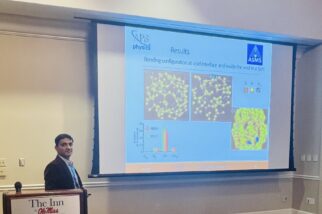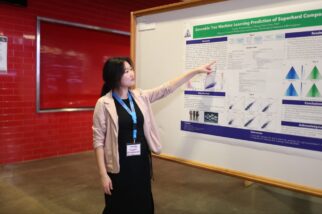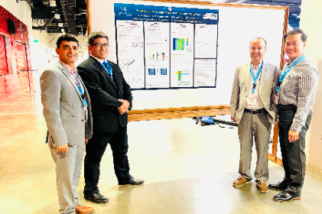ASMS Student, Instructor, and Parent Present at Esteemed Physics Conference
While you might not expect to see a high school make a strong showing at a college-level research conference, the Alabama School of Mathematics and Science (ASMS) did just that at the 89th Annual Meeting of the Southeastern Section of the American Physical Society. Commonly referred to as SESAPS, this prestigious conference highlights physics-related research from undergraduate students, graduate students, and college professors. Hosted on the Ole Miss campus this year, it also featured research from several ASMS community members: a student, a teacher, and a parent.
Tuyako Khristoforova, currently a senior at ASMS from Birmingham, presented a poster on using machine learning technology to identify superhard compound materials that could potentially replace diamonds in industrial applications. Working with her mentor, Dr. Cheng-Chien Chen from the University of Alabama at Birmingham, Tuyako used computer algorithms to sort through thousands of possible compounds, eventually determining the best method for doing the sorting. Tuyako’s work builds on that of her mentor, whom she met after completing a project in an ASMS course. She says, “I was able to get this opportunity because of an assignment from Intro to Research Methods where we had to cold-email five local university professors. Dr. Chen already completed this research, but he wanted me to use a different machine learning method and compare my results with his.”
Dr. Durga Paudel, a professor in the ASMS Physics Department, delivered a presentation on a substance that could be useful in the production of computer memory devices, LCD displays, solar panels, copy machines, and more. He used a computational method called small-angle X-ray scattering to study bonding disorders of hydrogen present in amorphous silicon materials. The goal of this particular research is to identify ways to make the creation of electronic devices more efficient and cost-effective. Dr. Paudel notes, “There are still possibilities to cut down the price of devices using the eco-friendlier, cheaper, and more easily available amorphous material.” Despite being a full-time high school physics teacher of such classes as Principles of Biophysics and Quantum and Relativity, Dr. Paudel remains committed to conducting cutting-edge nanomaterial research.
Having a student and a teacher present separate research projects at the conference would be impressive enough, but a third SESAPS participant rounded out the ASMS research family. Dr. Albert Gapud, a member of the University of South Alabama’s Physics Department and parent of a current ASMS senior, collaborated with researchers from the National High Magnetic Field Laboratory on nuclear magnetic resonance studies of vanadium silicide’s transition to superconductivity. He explains, “Although superconductors have already found many applications (like the magnet of an MRI machine), we won't really be able to explore their full potential without a better understanding of how they become superconducting in the first place.” Four of Dr. Gapud’s children have attended ASMS, with his oldest completing the ASMS Research Fellows Program just last year.
ASMS is proud to be represented by these three brilliant individuals, whose work underscores the excellent efforts of our research community, an interconnected group of scholars that often resembles a family. This is representative of why for 30 years ASMS has been leading the way in offering advanced STEM-based education to Alabama’s high school students and played a key role in developing Alabama’s STEM and industry leaders!


